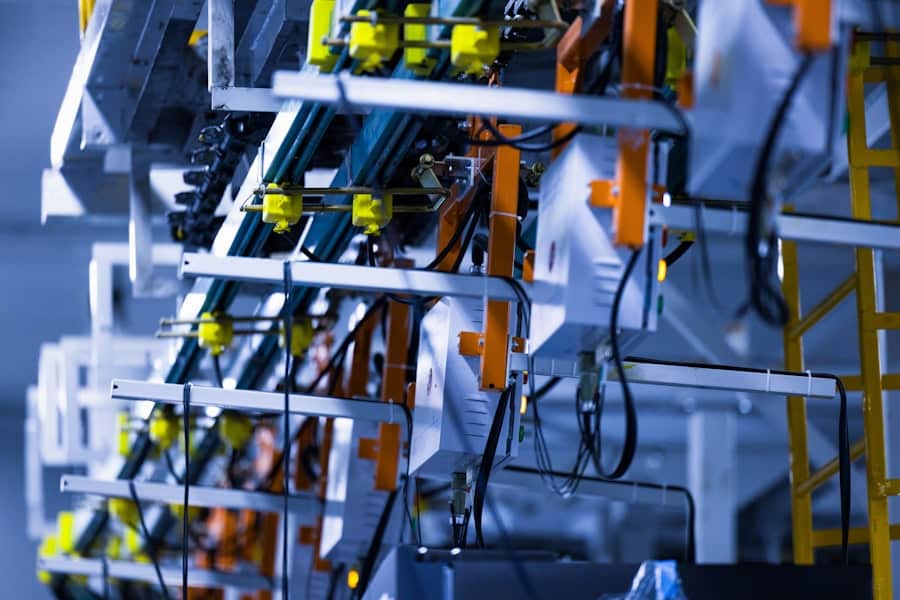The manufacturing sector has undergone a significant transformation over the past few decades, with automation emerging as a pivotal force driving efficiency and productivity. The rise of automation can be traced back to the advent of mechanization during the Industrial Revolution, but it has accelerated dramatically in recent years due to advancements in technology. The integration of sophisticated machinery, software, and data analytics has enabled manufacturers to streamline operations, reduce costs, and enhance product quality.
As global competition intensifies, companies are increasingly turning to automation as a means to maintain their competitive edge. One of the key factors contributing to the rise of automation in manufacturing is the rapid development of technologies such as robotics, artificial intelligence (AI), and machine learning. These innovations have made it possible for machines to perform complex tasks that were once the exclusive domain of human workers.
For instance, robotic arms can now assemble products with precision and speed that far surpasses human capabilities. Additionally, AI algorithms can analyze vast amounts of data to optimize production processes, predict equipment failures, and improve supply chain management. This convergence of technologies is not only transforming traditional manufacturing practices but also paving the way for the emergence of smart factories.
Key Takeaways
- Automation in manufacturing is on the rise, with more companies adopting smart factory technologies to improve efficiency and productivity.
- The benefits of automation in smart factories include increased production speed, improved product quality, and reduced labor costs.
- Integration of robotics and artificial intelligence is revolutionizing manufacturing processes, allowing for more flexible and adaptive production systems.
- The Internet of Things (IoT) plays a crucial role in smart factories, enabling real-time monitoring, predictive maintenance, and data-driven decision-making.
- Implementing automation in manufacturing comes with challenges such as high initial investment, cybersecurity risks, and the need for retraining the workforce.
Benefits of Automation in Smart Factories
The implementation of automation in smart factories offers a multitude of benefits that extend beyond mere cost savings. One of the most significant advantages is the enhancement of operational efficiency. Automated systems can operate continuously without the need for breaks, leading to increased production rates and reduced lead times.
For example, a fully automated assembly line can produce thousands of units per hour, significantly outpacing manual labor. This efficiency not only boosts output but also allows manufacturers to respond more swiftly to market demands. Moreover, automation contributes to improved product quality and consistency.
Automated processes are less prone to human error, ensuring that each product meets stringent quality standards. In industries such as automotive manufacturing, where precision is paramount, even minor deviations can lead to costly recalls or safety issues. By employing automated quality control systems equipped with advanced sensors and imaging technology, manufacturers can detect defects in real-time and make necessary adjustments on the fly.
This level of quality assurance not only enhances customer satisfaction but also strengthens brand reputation.
Integration of Robotics and Artificial Intelligence

The integration of robotics and artificial intelligence represents a significant leap forward in manufacturing capabilities. Robotics has evolved from simple machines performing repetitive tasks to sophisticated systems capable of learning and adapting to their environments. Collaborative robots, or cobots, are designed to work alongside human operators, enhancing productivity while ensuring safety.
These robots can be programmed to perform a variety of tasks, from assembly to packaging, and can easily be reconfigured for different production lines. Artificial intelligence complements robotics by providing the cognitive capabilities necessary for decision-making and problem-solving. AI algorithms can analyze data from various sources, including production metrics and market trends, to optimize manufacturing processes.
For instance, predictive maintenance powered by AI can forecast equipment failures before they occur, allowing manufacturers to schedule maintenance proactively and minimize downtime. This synergy between robotics and AI not only enhances operational efficiency but also enables manufacturers to innovate and adapt to changing market conditions more effectively.
The Role of Internet of Things (IoT) in Smart Factories
The Internet of Things (IoT) plays a crucial role in the development of smart factories by enabling seamless communication between machines, systems, and humans. IoT devices equipped with sensors collect real-time data on various aspects of the manufacturing process, such as machine performance, energy consumption, and inventory levels. This data is then transmitted to centralized systems for analysis, providing manufacturers with valuable insights into their operations.
One of the primary benefits of IoT integration is enhanced visibility across the supply chain. Manufacturers can monitor their entire production process in real-time, allowing for quick identification of bottlenecks or inefficiencies. For example, if a particular machine is underperforming, operators can receive alerts and take corrective action immediately.
Additionally, IoT technology facilitates better inventory management by providing accurate data on stock levels and usage patterns. This enables manufacturers to optimize their inventory levels, reducing carrying costs while ensuring that production schedules are met.
Challenges and Considerations in Implementing Automation
Despite the numerous advantages associated with automation in smart factories, several challenges must be addressed during implementation. One significant hurdle is the initial investment required for automation technologies. While the long-term benefits often outweigh these costs, many manufacturers may struggle to secure the necessary funding or justify the expenditure in a competitive market environment.
Additionally, integrating new technologies into existing systems can be complex and time-consuming, requiring careful planning and execution. Another critical consideration is the potential impact on the workforce. As automation takes over routine tasks, there is a growing concern about job displacement among workers.
While automation can create new opportunities for skilled labor in areas such as programming and maintenance, it may also lead to job losses in lower-skilled positions. Manufacturers must navigate this delicate balance by investing in workforce training and development programs that equip employees with the skills needed to thrive in an increasingly automated environment.
Impact of Automation on the Workforce

The impact of automation on the workforce is multifaceted and warrants careful examination. On one hand, automation has the potential to enhance job satisfaction by relieving workers from monotonous and physically demanding tasks.
This shift allows workers to focus on more strategic aspects of production that require critical thinking and creativity. Conversely, there is a legitimate concern regarding job displacement as machines take over tasks traditionally performed by humans. The fear of widespread unemployment has led to calls for policies that support workforce transition and reskilling initiatives.
Governments and industry leaders must collaborate to create training programs that prepare workers for new roles in an automated landscape. For example, partnerships between educational institutions and manufacturing companies can facilitate the development of curricula that align with industry needs, ensuring that workers are equipped with relevant skills for future employment opportunities.
Case Studies of Successful Smart Factory Implementations
Several companies have successfully implemented smart factory concepts, showcasing the transformative potential of automation in manufacturing. One notable example is Siemens’ Amberg Electronics Plant in Germany, which has become a benchmark for smart manufacturing practices. The facility employs advanced automation technologies such as robotics and IoT sensors to achieve a production efficiency rate exceeding 99%.
By leveraging real-time data analytics, Siemens has optimized its production processes while maintaining high-quality standards. Another compelling case study is that of General Electric (GE) at its Durathon battery plant in Schenectady, New York. GE has integrated advanced robotics and AI-driven analytics into its manufacturing processes to enhance efficiency and reduce costs.
The plant utilizes predictive maintenance strategies powered by IoT data to minimize downtime and ensure optimal performance of machinery. As a result, GE has significantly improved its production capabilities while reducing waste and energy consumption.
Future Trends and Innovations in Smart Factory Automation
Looking ahead, several trends are poised to shape the future of smart factory automation. One prominent trend is the increasing adoption of edge computing technology. By processing data closer to where it is generated—at the “edge”—manufacturers can achieve faster response times and reduce latency issues associated with cloud computing.
This shift will enable real-time decision-making on the factory floor, enhancing operational efficiency. Additionally, advancements in machine learning will continue to drive innovation in smart factories. As algorithms become more sophisticated, they will enable machines to learn from historical data and improve their performance over time without human intervention.
This self-optimizing capability will further enhance productivity while reducing reliance on manual oversight. Furthermore, sustainability will play an increasingly critical role in shaping smart factory practices. As environmental concerns grow, manufacturers will seek ways to minimize their carbon footprint through energy-efficient processes and sustainable materials sourcing.
In conclusion, the rise of automation in manufacturing heralds a new era characterized by enhanced efficiency, improved product quality, and innovative practices that redefine traditional manufacturing paradigms. As companies navigate the complexities of implementing these technologies, they must remain mindful of their impact on the workforce while embracing opportunities for growth and sustainability in an ever-evolving landscape.
In the rapidly evolving landscape of smart factories, automation is playing a pivotal role in shaping the future of manufacturing. As industries strive to enhance efficiency and productivity, the integration of advanced technologies becomes crucial. A related article that delves into optimizing processes through technology is Top 10 Best Scheduling Software for 2023: Streamline Your Schedule Effortlessly. This article explores how effective scheduling software can significantly improve operational workflows, a key component in the automation strategies of smart factories. By leveraging such tools, manufacturers can ensure seamless coordination and execution of tasks, further driving the future of automated production environments.
FAQs
What is automation in the context of smart factories?
Automation in the context of smart factories refers to the use of advanced technologies such as robotics, artificial intelligence, and machine learning to automate and optimize manufacturing processes. This includes tasks such as production, quality control, inventory management, and maintenance.
How is automation driving the future of smart factories?
Automation is driving the future of smart factories by enabling increased efficiency, productivity, and flexibility in manufacturing processes. It allows for the seamless integration of machines, data, and processes, leading to improved decision-making, reduced downtime, and enhanced overall performance.
What are the benefits of automation in smart factories?
The benefits of automation in smart factories include increased production speed, improved product quality, reduced labor costs, enhanced safety, and the ability to adapt to changing market demands. Automation also enables predictive maintenance, real-time monitoring, and the optimization of energy usage.
What are some examples of automation technologies used in smart factories?
Examples of automation technologies used in smart factories include industrial robots, automated guided vehicles (AGVs), 3D printing, IoT (Internet of Things) devices, and advanced analytics software. These technologies work together to create a connected and intelligent manufacturing environment.
What are the challenges of implementing automation in smart factories?
Challenges of implementing automation in smart factories include the initial investment costs, the need for specialized technical expertise, potential job displacement, and cybersecurity risks. Additionally, integrating automation technologies with existing manufacturing systems can be complex and require careful planning.

